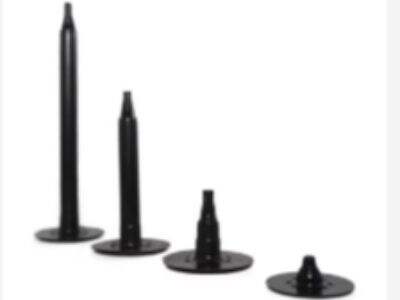Due to their function of keeping insulation from the base material inX place, fasteners are essential. That's insulation, the stuff that makes buildings warm in the winter and cool in the summer. Choosing the right type of fastener can be a challenge when working on a project that needs to be insulated. To assist you in this process, we have devised a few helpful tips to makes the selection for ideal thermal insulation fasteners, for your projects much more simple.
Types of Insulation Fasteners
There are lots of different fasteners that you can use for your insulation project. There are a number of common varieties for fasteners like these, such as pins, clips, and washers. Different types of fasteners are designed to suit specific insulation materials and wall surfaces with relevant properties. The main types of fasteners you might want to consider are:
Insulation Fastening Pins – the most common fasteners used for thermal insulation They are made in a wide variety of materials and lengths, so it is possible to get a size that fits your needs. You can glue them on, weld them, or something like that. Now the great attribute of insulation pins is that they are extremely potent. That makes them ideal for securing heavy insulation in place.
Clips – Clips are lighter than pins and are ideal for securing thin insulation materials. They include Z-clips, T-clips, and hook-and-loop clips. These clips are typically used as soundproofing or for decorative finishing of a room. If your insulation is not all that thick, clips may be the best option for you.
Washer – Flat pieces that distribute the pressure of the foam board fasteners over a larger area. Therefore, it is essential to safeguard your insulation material from harm. Washers are typically used along with soft insulation materials, such as fiberglass blankets or batts, to hold them in place without ripping.
How to Use This Guide Fastener Basics Step 1: Identify the Material Step 2: Measure the Length Step 3: Choose the Head Style Step 4: Select the Finish Step 5: Determine the Size Step 6: Choose the Right Fastener for the Job Step 7: Drill the Hole Size Step 8: Estimate the Quantity
Which type of fastener you select for your insulation job is extremely crucial. You have to consider what type of insulation material you got and the fastened surface you are going to apply it to. Here are some key factors to weigh in making your decision:
Insulation Material – There are many different types of insulation materials, they can be heavy or light in nature. Heavy-duty insulation, such as rock wool, requires robust fasteners like insulation pins to secure it. In contrast, lighter insulation products can usually be attached with clips or washers, which are less labour-intensive to install.
Type of Surface — The nature of surface to which you are applying the fasteners is a major consideration. For instance, when you are dealing with a concrete surface, you will require strong mechanical fasteners. However if you are attaching a foam fasteners to clean metal surfaces, adhesive options may work just as well. You can use your surface type to help you choose a fastener.
Project Requirements – Each project has its requirements. Depending on your project, you may need certain types, shapes or sizes of your insulation fasteners. Getting some advice on this matter from an expert can be beneficial because they will know from the specifics of your project what will work best.
Important Tips for Fasteners
To ensure successful installation while working with insulation fasteners, here are some key tips to note:
Safety – When it comes to installing insulation fasteners, safety always comes first. This means you need to have protective gear such as gloves and protective goggles. Also, ensure your work area is free of any electrical or mechanical dangers, and address any potential hazards.
Compatibility– Insulation fastener should be compatible with the insulation material and also the surface type. Choosing the wrong insulation fasteners could loosen or fail, leading to issues with the insulation itself. Compatibility ensures that everything is functioning as it should.
The spacing of insulation fasteners is critical to the effectiveness of your insulation. Space them too far apart, and the insulation will sag, creating gaps through which heat escapes. This is known as thermal bridging, which can compromise the value of your insulation.
Choosing the Best Fasteners
If you are selecting the right fasteners to suit your insulation project, consider multiple factors:
Keep insulation in place reliably - Fasteners are intended to attach insulating frames on walls, ceilings and floors. This can help keep insulation performing, too. Selecting the correct fastener ensures your insulation material is held in place without leaving warms gaps or holes for thermal escape.
Ease of installation – Another important consideration is how easy the fasteners are to install. Selecting a simple to install fastener will also save you time and installation cost. Installing insulation in the right places is necessary for it to do its job.
Cost- Effectiveness – Finally, cost-effectiveness is a consideration that must be taken into account while selecting insulation fasteners. You do NOT want to spend more on a fastener that gets a good performance rating and is easy to install. Finding this balance will help you make a great decision.
Expert Help with Fasteners
There are numerous insulation fasteners to select from, and the right one will make or break your insulation system. If you need assistance, Yifang can help you choose the appropriate insulation fastener for your project. Our products are affordable, high-quality, and long-lasting. Feel free to reach out to us to find out more about our products for insulation fastener and the expertise we can provide.
 EN
EN
 AR
AR
 BG
BG
 HR
HR
 CS
CS
 DA
DA
 NL
NL
 FI
FI
 FR
FR
 DE
DE
 EL
EL
 HI
HI
 IT
IT
 JA
JA
 KO
KO
 NO
NO
 PL
PL
 PT
PT
 RO
RO
 RU
RU
 ES
ES
 SV
SV
 TL
TL
 IW
IW
 ID
ID
 SR
SR
 UK
UK
 VI
VI
 HU
HU
 TH
TH
 TR
TR
 FA
FA
 MS
MS
 GA
GA
 IS
IS
 LA
LA
 MN
MN
 NE
NE
 KK
KK
 UZ
UZ



